137 results
4 - Establishing Ties with Apartheid South Africa
- from Part I - Establishing Relations (c. 1957–1970)
-
- Book:
- Pahlavi Iran's Relations with Africa
- Print publication:
- 27 June 2024, pp 94-116
-
- Chapter
- Export citation
14 - Perspectives and Prospects
-
- Book:
- The Archaeology of Southern Africa
- Published online:
- 15 May 2024
- Print publication:
- 06 June 2024, pp 432-450
-
- Chapter
- Export citation
South Africa, 1994 + 30: A Conversation About History After Apartheid
-
- Journal:
- The Journal of African History , First View
- Published online by Cambridge University Press:
- 24 April 2024, pp. 1-18
-
- Article
-
- You have access
- Open access
- HTML
- Export citation
11 - Redistributive Justice, Transformational Taxes and the Legacies of Apartheid
- from Part III - Imagining Alternative Futures of Redistributive Justice in South Africa
-
-
- Book:
- Beyond Expropriation Without Compensation
- Published online:
- 28 March 2024
- Print publication:
- 04 April 2024, pp 268-287
-
- Chapter
-
- You have access
- Open access
- HTML
- Export citation
4 - De-racializing the Liquor Laws
-
- Book:
- Race, Taste and the Grape
- Published online:
- 16 March 2024
- Print publication:
- 28 March 2024, pp 128-147
-
- Chapter
- Export citation
15 - The South African Landownership Struggle
- from Part III - Sustainable Urban Planning in Africa
-
-
- Book:
- Reimagining Urban Planning in Africa
- Published online:
- 07 December 2023
- Print publication:
- 21 December 2023, pp 261-281
-
- Chapter
- Export citation
5 - 1967 and After: The UN and the Occupied Palestinian Territory
-
- Book:
- The United Nations and the Question of Palestine
- Published online:
- 16 November 2023
- Print publication:
- 30 November 2023, pp 172-216
-
- Chapter
- Export citation
Postscript
-
- Book:
- The United Nations and the Question of Palestine
- Published online:
- 16 November 2023
- Print publication:
- 30 November 2023, pp 264-268
-
- Chapter
- Export citation
Raids, Resistance, and Retribution: South Africa's Cato Manor Killings, 1960–1
-
- Journal:
- The Journal of African History / Volume 64 / Issue 3 / November 2023
- Published online by Cambridge University Press:
- 13 December 2023, pp. 422-436
- Print publication:
- November 2023
-
- Article
-
- You have access
- Open access
- HTML
- Export citation
10 - The Anti-Aryan Moment
- from Part IV - A Troubled Middle East (1960–1979)
-
- Book:
- Heroes to Hostages
- Published online:
- 03 August 2023
- Print publication:
- 24 August 2023, pp 241-263
-
- Chapter
- Export citation
South Africa's Revolutionary Era - Spear: Mandela and the Revolutionaries By Paul S. Landau. Athens: Ohio University Press, 2022. Pp. 372. $80.00, hardcover (ISBN: 9780821424704); $36.95, paperback (ISBN: 9780821424797); ebook (ISBN: 97808214476970).
-
- Journal:
- The Journal of African History / Volume 64 / Issue 2 / July 2023
- Published online by Cambridge University Press:
- 17 July 2023, pp. 316-320
- Print publication:
- July 2023
-
- Article
- Export citation
6 - A Secular ‘State of Grace’?
-
- Book:
- J. M. Coetzee and the Limits of the Novel
- Published online:
- 08 June 2023
- Print publication:
- 22 June 2023, pp 139-159
-
- Chapter
- Export citation
Chapter 3 - Figures of Risk
-
- Book:
- China in Twentieth- and Twenty-First-Century African Literature
- Published online:
- 01 June 2023
- Print publication:
- 15 June 2023, pp 103-156
-
- Chapter
- Export citation
Conclusion
-
- Book:
- Writing, Politics and Change in South Africa after Apartheid
- Published online:
- 08 August 2023
- Print publication:
- 08 June 2023, pp 203-208
-
- Chapter
- Export citation

Writing, Politics and Change in South Africa after Apartheid
-
- Published online:
- 08 August 2023
- Print publication:
- 08 June 2023
6 - Surveillance in South Africa
-
-
- Book:
- The Cambridge Handbook of Race and Surveillance
- Published online:
- 23 February 2023
- Print publication:
- 02 March 2023, pp 97-122
-
- Chapter
- Export citation
Administering the KwaZulu Bantustan - Bantu Authorities: Apartheid's System of Race and Ethnicity By Veronica Ehrenreich-Risner. Lanham, MD: Lexington Books, 2021. Pp. xxi + 365. $120.00, hardcover (ISBN: 9781793631268); $45.00, e-book, (ISBN: 9781793631275).
-
- Journal:
- The Journal of African History / Volume 64 / Issue 1 / March 2023
- Published online by Cambridge University Press:
- 23 February 2023, pp. 153-155
- Print publication:
- March 2023
-
- Article
- Export citation
7 - The Wind Changes: Human Rights after Smuts
- from Part II - Registers
-
- Book:
- Untied Kingdom
- Published online:
- 16 February 2023
- Print publication:
- 16 February 2023, pp 194-226
-
- Chapter
- Export citation
Chapter 13 - Apartheid’s Ghosts
- from Part IV - Metaphors and Migrations
-
-
- Book:
- The Cambridge Companion to Global Literature and Slavery
- Published online:
- 15 December 2022
- Print publication:
- 22 December 2022, pp 219-234
-
- Chapter
- Export citation
Chapter 13 - Apartheid
- from Part II - 1945–1989: New Nations and New Frontiers
-
-
- Book:
- The Cambridge Companion to Twentieth-Century Literature and Politics
- Published online:
- 01 December 2022
- Print publication:
- 15 December 2022, pp 212-226
-
- Chapter
- Export citation



